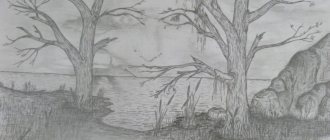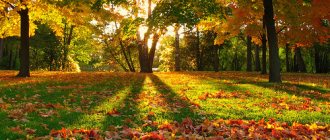Preview:
Municipal autonomous preschool educational institution
city of Naberezhnye Chelny “Combined kindergarten No. 23 “Firefly”
Summary of a drawing lesson in the preparatory group
Naberezhnye Chelny, 2016.
Arouse children's interest in late autumn, mosses growing on trees, stones, and forests, and develop the ability to be emotionally distracted by the mood of sadness conveyed in poetry. Arouse the desire to express this state with the help of color in a landscape drawing.
- practice naming autumn signs to enrich children’s vocabulary;
- form ideas about neutral colors (black, white, dark gray, light gray, brown), use these colors when creating paintings of late autumn;
- develop the ability to independently convey in a drawing the landscape of late autumn, its color (the absence of bright colors in nature);
- practice the ability to draw trees of different structures and bushes without leaves, draw growing moss on trees, stones and ground;
- consolidate drawing techniques with the end of the brush;
-continue to develop the ability to feel, understand and reproduce the imagery of the language of a poem;
- develop coordination of movements, accompanying speech;
— develop fine motor skills through finger play;
- cultivate a love for poetry and native nature;
- cultivate an aesthetic perception of nature;
— to cultivate in children an interest in drawings, a desire to look at and talk about them.
Sample made by the teacher. Landscape sheets of paper, watercolors, palette, brushes.
Reading poems by Russian poets about autumn by A. N. Pleshcheev, A. S. Pushkin, and others.
Memorizing poems about autumn “Autumn” by M. Khodyakov and “The Swallows Are Missing” by A. Fet. Poems about mosses.
A conversation about late autumn and its signs.
Examination of reproductions of paintings by famous artists in the presentation “Late Autumn through the Eyes of Artists.” Presentations about mosses.
Examination of illustrations, pictures, reproductions.
Observations (of the sky; trees; growing mosses: on trees, foundations, ground; rain; snow) while walking.
— Guys, what time of year is it now?
— What autumn months do you know? What month is it? November is the last month of autumn.
- Listen to A. Pleshcheev’s poem, what autumn is the poet talking about?
Withers and turns yellow
Grass in the meadows
A cloud covers the sky
The sun doesn't shine
The wind howls in the field,
—Are you happy about this picture painted by the poet?
— What signs of late autumn does Pleshcheev talk about in the poem?
I. Sokolov-Mikitov “Autumn”
The chirping swallows have long since flown south, and even earlier, as if on cue, the swift swifts disappeared. On autumn days, the children heard the passing cranes crowing in the sky as they said goodbye to their dear homeland. They looked after them for a long time with some special feeling, as if the cranes were taking summer with them. Quietly talking, the geese flew to the warm south...
People are preparing for a cold winter. The rye and wheat were mowed long ago. We prepared feed for the livestock. The last apples are being picked from the orchards. They dug up potatoes, beets, and carrots and put them away for the winter.
The animals are also preparing for winter. The nimble squirrel accumulated nuts in the hollow and dried selected mushrooms. Little voles brought grains into the holes and prepared fragrant soft hay. In late autumn, a hardworking hedgehog builds its winter lair. He dragged a whole heap of dry leaves under an old stump. You will sleep peacefully all winter under a warm blanket.
The autumn sun warms less and less often, more and more sparingly. Soon, soon the first frosts will begin. Mother Earth will freeze until spring. Everyone took from her everything she could give.
G. Skrebitsky “Four Artists. Autumn"
For her work, the Autumn Artist took the brightest colors and first of all went into the forest with them. There she began to work on her painting. She covered the birches and maples with lemon yellow. And the aspen leaves turned red like ripe apples. The aspen tree became all bright red, all burning like fire.
Autumn wandered into a forest clearing. A hundred-year-old oak tree stands in the middle of a clearing, standing and shaking its thick leaves. Autumn thinks: “We need to dress the hero in bloody copper armor.” This is how I dressed the old man. He looks - and not far away, at the very edge of the clearing, thick, spreading linden trees have gathered in a circle, their branches lowered down. A heavy headdress made of gold brocade is most suitable for them.
Autumn decorated all the trees and even the bushes in its own way, in an autumnal way: some dressed in yellow, others in bright red. She only didn’t know how to decorate the pine and spruce trees. After all, they don’t have leaves on their branches, but needles, and you can’t paint them. Let them remain the same as they were in the summer. So the pines and spruce trees remained dark green in summer. And this made the forest even brighter, even more elegant in its colorful autumn attire.
Autumn went from the forest to the fields, to the meadows, removed the golden grain from the fields, and in the meadows swept the fragrant haystacks into stacks high, like towers. The fields and meadows became empty, even wider and more spacious. And schools of migratory birds stretched above them in the autumn sky: cranes, geese, ducks...
On the topic: methodological developments, presentations and notes
GCD for drawing in the preparatory group Non-traditional drawing.
Develop the idea that through the selection of colors you can convey in a drawing certain weather and mood characteristic of rainy late autumn. Introduce children to a new way of expression.
This type of activity was created taking into account the use of the “Childhood” program.
Arouse children's interest in late autumn, mosses growing on trees, stones, and forests, and develop the ability to be emotionally distracted by the mood of sadness conveyed in poetry. Call
Program content: learn to understand how composers, poets, artists, using different means of expression (color, composition, rhythm), convey the image of autumn; develop the ability to collectively
Summary of a drawing lesson in the preparatory group. Still life "Autumn gifts".
It is known that drawing is one of the most favorite children's activities, which cultivates many positive qualities in a child, such as perseverance and patience, attentiveness, imagination, and ability.
Mikhail Prishvin “Late Autumn”
Autumn lasts like a narrow path with sharp turns. First frost, then rain, and suddenly snow, like in winter, a white blizzard with a howl, and again the sun, again warm and green. In the distance, at the very end, a birch tree stands with golden leaves: it remained frozen as it was, and the wind can no longer tear off the last leaves from it - everything that was possible was torn off.
The very end of autumn is when the rowan shrivels from frost and becomes, as they say, “sweet.” At this time, the latest autumn comes so close to the earliest spring that you can only recognize the difference between an autumn day and a spring day - in the fall you think: “I’ll survive this winter and rejoice in another spring.”
Then you think that everything in life must be like this: you have to exhaust yourself, work hard, and after that you can enjoy something. I remembered the fable “The Dragonfly and the Ant” and the ant’s stern speech: “You kept singing - that’s the point, so come and dance.” And in early spring, on exactly the same day, you expect joy without any merit; spring will come, you will come to life in it and fly like a dragonfly, without thinking about the ant at all.
Source
N. Sladkov “Autumn is on the threshold”
- Forest dwellers! - the wise Raven shouted one morning. — Autumn is at the threshold of the forest, is everyone ready for its arrival? Like an echo, voices came from the forest: “Ready, ready, ready...” “But we’ll check now!” - Raven croaked. - First of all, autumn will let the cold into the forest - what will you do? The animals responded: “We, squirrels, hares, foxes, will change into winter coats!” - We, badgers, raccoons, will hide in warm holes! - We, hedgehogs, bats, will fall into a deep sleep! The birds responded: “We, migratory birds, will fly away to warmer lands!” - We, settled ones, will put on down padded jackets! “Secondly,” the Raven shouts, “autumn will begin to rip off the leaves from the trees!” - Let him rip it off! - the birds responded. - The berries will be more visible! - Let him rip it off! - the animals responded. - It will be quieter in the forest! “The third thing,” the Raven continues, “autumn will click the last insects with frost!” The birds responded: “And we, blackbirds, will fall on the rowan tree!” - And we, woodpeckers, will begin to peel the cones! - And we, goldfinches, will get to the weeds! The animals responded: “And we will sleep more peacefully without mosquito flies!” “The fourth thing,” the Raven buzzes, “autumn will become boring!” He will catch up with dark clouds, let down tedious rains, and incite dreary winds. The day will be shortened, the sun will be hidden in your bosom! - Let him pester himself! - the birds and animals responded in unison. - You won’t keep us bored! What do we care about rain and winds when we are wearing fur coats and down jackets! Let's be well-fed - we won't get bored! The wise Raven wanted to ask something else, but he waved his wing and took off. He flies, and beneath him is a forest, multi-colored, motley - autumn. Autumn has already crossed the threshold. But it didn’t scare anyone at all.



